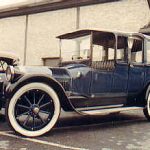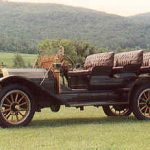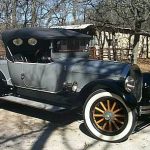- Home
- About Us
- Join/Renew
- Member Benefits
- Member Pages
- Log In
- Help
- Museum Store
Pierce-Arrow continued the triple line-up of cars available in 1910 throughout the decade. While there were continual refinements over the years, the heritage of these cars is evident. The smallest of the three models was the 36-UU mounted on a 119 inch wheelbase and selling for $3850. The 36 hp model had a 4″ x 4 3/4″ six cylinder engine with the cylinders cast in pairs. The mid-sized car was the 48-SS, having a 4 1/2 inch x 4 3/4 inch six cylinder engine. The top of the line was the 66-QQ mounded on a 134 inch wheelbase and having a 5 1/4 x 5 1/2 six cylinder engine.

For 1913, the cars now offered electric headlights, although the trademark fender-mounted headlights did not appear until 1914. The 1913 cars also had a self-starter of the compressed air variety. An electric starter was used in 1914. The 1913 cars, known as Series One, had grown from the 1910 versions. The 38-C-1 (formerly the 36-UU) now had 132 inch wheelbase; the 48-B-1 was stretched to 142 inches; and the 66-A-1 was mounted on a 147 1/2 inch wheelbase. The engine in the 66 had also grown to a 5×7 bore & stroke. This pushed the displacement to 824 cubic inches, t e largest production automobile engine ever made.

The Series Three cars of 1915 added a pressure fuel system to replace the gravity system of the earlier cars. The pressure system used a small hand-pump on the dash and a cam-driven pump on the engine to provide a small amount of air pressure in the rear-mounted tank to push the gasoline to the carburetor, which was now mounted higher.
The Series Four cars appeared in 1916 and were continued into 1918. There were minor changes between the Series 4 cars and the earlier Series Three cars. While the passenger cars being produced appeared to change only slightly, there were many changes happening at Pierce-Arrow. The company was quite successful, with profits of $4 million annually. In 1916, the Company began an expansion effort on it’s Elmwood Avenue factory and offered for sale $10.7 million in public stock. This was the first public offering of Pierce-Arrow stock. It was also this year that Pierce-Arrow president George Birge retired, selling approximately half of his Pierce-Arrow stock for $7 million, quite a tidy sum of money at the time.

Throughout World War I, the Pierce-Arrow commercial line was busy turning out two and five-ton trucks. These trucks were ordered by the hundreds by both the French and English governments. Truck production exceeded passenger car production may times over.After the War, the Series Five passenger cars were introduced in 1918. Still a refinement of the earlier cars, the Series Five cars had a dual-valve engine. While still a “T” head arrangement of the earlier models, the Series 5 cars had two intake and two exhaust valves per cylinder. The dual-valve engine gave an increase in performance over the earlier single-valve cars. The big 66 hp and the small 38 hp models were discontinued, however. Only the mid-sized car remained in the 48-B-5.
The Dual-Valve Six would be continued, with modifications through the 1928 Series 36 models.
As the decade closed, Pierce-Arrow could look back on it’s most successful years ever. The Pierce-Arrow was undoubtedly one of the most prestigious automobiles made. While the basic cars offered in 1910 had evolved over the years to become the Series 5, major changes had been happening at the Company. Many of the old management was gone, more would be gone soon. Instead of being owned by the company management, Pierce-Arrow was now a publicly owned company. John Jay Jr., a partner with Seligman & Co., was now president.
